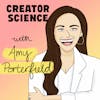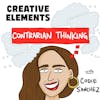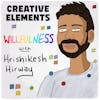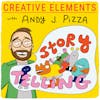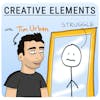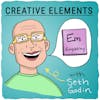
#92: Cathryn Lavery – From Kickstarter to global 8-figure e-commerce business
Play EpisodeCathryn Lavery is the Founder & CEO of BestSelf. Since 2013 she's designed, launched and sold over $32 Million in consumer products.
Cathryn Lavery is the Founder & CEO of BestSelf. Since 2013 she's designed, launched and sold over $32 Million in consumer products.
Along the way, BestSelf Co. won Shopify’s Build a Business Competition in 2016 and the Build a BIGGER Business competition in 2017 – the only company to win both awards consecutively. We have been featured in the New York Times, Entrepreneur, MTV, Huffington Post, Forbes, Inc., and more. We’re funded solely through the investments made by thousands of customers who have used our products to change their lives.
In this episode, we talk about Cathryn’s first business as a 13-year old, her New York architecture job that put her back on the path to entrepreneurship, what’s changed for Kickstarter products and e-commerce businesses today, and why keeping Best as the Standard for her work has helped her find success in e-commerce.
Learn more about Cathryn Lavery
Follow Cathryn Lavery on Twitter
Follow Cathryn Lavery on Instagram
Follow Creative Elements on Instagram
Full transcript and show notes
***
SPONSORS
***
IF YOU LOVE CREATIVE ELEMENTS
Subscribe to weekly episode emails
Leave a review on Apple Podcasts
***
ABOUT JAY CLOUSE
Subscribe to my newsletter, Creative Companion
***
FOR PODCASTERS
Enroll in my podcasting workshop
Enroll in my course on podcasting, Podcast Like The Pros
***
PODGLOMERATE NETWORK
This show is a part of the Podglomerate network, a company that produces, distributes, and monetizes podcasts. We encourage you to visit the website and sign up for our newsletter for more information about our shows, launches, and events. For more information on how The Podglomerate treats data, please see our Privacy Policy.
Since you're listening to Creative Elements, we'd like to suggest you also try other Podglomerate shows surrounding entrepreneurship, business, and careers like Rocketship.fm and Freelance to Founder.
Learn more about your ad choices. Visit megaphone.fm/adchoices
Cathryn Lavery 00:00
Sometimes I would get sales because I didn't run ads or do anything like that. I would literally get sales and I'm like, oh, which blog talked about me today? That's, that was my marketing strategy. And so there were some where like, MTV picked it up.
Jay Clouse 00:16
Welcome to Creative Elements, a show where we talk to your favorite creators and learn what it takes to make a living from your art and creativity. I'm your host, Jay Clouse. Let's start the show. Hello, my friend, welcome back to another episode of Creative Elements. Over the last few weeks, I've been learning a lot about video and lighting. I'm transforming my home studio into a space that can not only capture great audio, but can be used to create great video as well. It's really stretched me creatively, cameras and lighting are things that I knew next to nothing about just a couple of weeks ago. And that unfamiliarity has made me uncomfortable with the idea of investing in really good equipment. But we all started as unfamiliar with everything that we know today. And for some reason, as we get older, we just seem to be less willing to admit that we don't know things, we are less willing to be bad at things. But of course, we're going to be bad at things that we've never done before. Anyway, I'm making a conscious decision to be comfortable with being uncomfortable with things and still embrace learning them anyway, even if it feels awkward and painful at first. That goes for this show, too. I said a few weeks ago that this year, I really want to explore some areas that are outside of my experience, and out of my wheelhouse. And today, we are continuing that trend. Today, I'm speaking with Cathryn Lavery. Catherine who also goes by Cath has created, launched and sold over $25 million in direct to consumer products. She is a consummate entrepreneur, going all the way back to when she was a kid.
Cathryn Lavery 02:04
I always wanted to make my own money. So I didn't like like I like getting pocket money, but I didn't get very much. And so I was the kid walking around the neighborhood asking the neighbors if I could cut their grass or wash their car. And then luckily I was in a safe neighborhood. And they would just call my parents and like your daughter's here, like try to do chores.
Jay Clouse 02:24
Cathryn was born in Canada and raised in Belfast, Northern Ireland. She graduated from the Glasgow School of Art with a master's in architecture and moved to New York City. But as you'll hear in the interview, that job that brought her to New York did not go as planned. And out of necessity, Cathryn began a graphic design business on the side. And it wasn't long until she started another business that brought her back to entrepreneurship full time.
Cathryn Lavery 02:50
I had been getting into personal development for a few years, the more I got better and developed myself, the better the business did. And I developed this product which became the self journal, which was just the structure for your goals and how to achieve more in your day. And so for me, I was like, oh, I can make this a product. How do I create structure in my life? What do I need to do to be successful? Why am I not progressing like I want to? These are the questions we asked ourselves when we were caught in a period of directionless overwhelm. Hi, I'm Cathryn.
Allen Brouwer 03:23
And I'm Allen and we're the duo behind Self Journal, a powerful yet simple daily planner to help you structure your day, enjoy your life and reach your goals quicker than you ever thought possible.
Jay Clouse 03:35
Cathryn and her co-creator launched the self journal on Kickstarter on August 19th 2015. They set a $15,000 public goal for their Kickstarter campaign. They had raised nearly $13,000 In the first 24 hours across their $15,000 goal in just over a day, and ended their campaign with over $322,000 pledged for more than 6500 backers. Hundreds of 1,000 of dollars may sound crazy to you but it wasn't crazy to Cathryn, she said the team actually had a secret internal goal to earn $200,000 with the campaign, but it was surprising to exceed their internal goal by more than $100,000.
Cathryn Lavery 04:16
Oh, that was insane because it started as a passion project, a product that I wanted to exist. And I had done crowdfunding campaigns before with the graphic design and this crazy goal that we had inside. I didn't tell many people because the people I told were like, oh, I don't know that's gonna happen. So I just didn't share but the 200,000 goal was like, okay, this could be a real thing if we hit that data mine. And so I learned through a couple of campaigns doing that how to do a Kickstarter, but this was like a whole new list of people a whole new product. So I was like, okay, let me see if I really know how to do this. And so when that one worked out so well, it was like, wow, this could be a real thing.
Jay Clouse 04:54
The Self Journal kicked off the creation of BestSelf CO, a global e-commerce business with eight figures in revenue.
Cathryn Lavery 05:01
In 2020, we did 8 million in sales.
Jay Clouse 05:05
Crazy.
Cathryn Lavery 05:06
And we're going to surpass that this year.
Jay Clouse 05:09
How many units are we talking about?
Cathryn Lavery 05:11
God, you have me do math, no, I mean, our average order value is $55.
Jay Clouse 05:18
Like 145,000 units.
Cathryn Lavery 05:21
Yeah.
Jay Clouse 05:22
Along the way, BestSelf won Shopify's Build A Business Competition in 2016, and the Build A Bigger Business Competition in 2017, the only company to win both awards consecutively. They've been featured in The New York Times, Entrepreneur, MTV, Huffington Post, Forbes, Inc, and they've been funded solely through the investments made by 1,000 of customers who have used their products to change their lives. So in this episode, we talk about Cathryn's first business as a 13 year old, her New York architecture job that put her back on the path to entrepreneurship, what's changed for Kickstarter products and e-commerce businesses today, and why keeping best as the standard for her work has helped her find success in e-commerce. I'd love to hear your thoughts on this episode. As you listen, you can find me on Twitter @jayclouse or on Instagram @creativeelements.fm tag me, say hello, let me know that you're listening. And now let's talk to Cathryn.
Cathryn Lavery 06:24
When I was at school, I had an eBay store. And I don't know if it's Warren Buffett or someone talks about you know, sell what you know, or invest in what you have knowledge you're on. So, you know, at 13 my knowledge is very narrow focused. And so what I sold was Dawson's Creek DVDs that I would import from Canada. So I was a drop shipper when I was 13. And I didn't sell those where I was from. So I used to watch this show. And so I some I don't even want to know, hi, I got in contact with some guy that sold Dawson's Creek DVDs in Canada. And I negotiate a deal with him where I would put them up on eBay. And then he would ship them to the person that would buy them from me.
Jay Clouse 07:07
How does 13 year old Cath realize there's an arbitrage opportunity selling DVDs, and even specifically Dawson's Creek DVDs on eBay?
Cathryn Lavery 07:16
Well, I think at the time, I was looking for DVDs, and I couldn't find them because they didn't sell them there. And so then I find this guy that sold them. And I was thinking, well, if I'm looking for them, other people might be looking for them. It went from there. And you know, I was 13 so I couldn't get a PayPal account so I had to set my mom up. And she had no idea what was going on because sometimes I would get like checks in the mail and a pile of things. And she was like, what is she up to?
Jay Clouse 07:41
How did you even realize this was an opportunity. Like when I was 13, there is no way I was thinking that I could sell things to other people.
Cathryn Lavery 07:50
For me, I think I was really interested in the internet, you know when I was young. And then I think I was you know, as 13, 14 was the eBay stuff. Then I learned about arbitrage. And there was this website that was kind of like Amazon in the UK, but it was called like play.com. And I was like well, I can buy DVDs nd it's free shipping. And you can white label them from this official store. And I'll just list them on eBay. And if it sells, I'll just put this order in this website and put the customer address and white label and they won't know that it's from this official site. So it was like just weird stuff like that I would do. I saw Justin Timberlake, video, CDs, not even DVDs, which is complete, like copyright infringement looking back, but I just downloaded all this interviews and videos and I put them on it on a video CD, again, not a DVD. And I made the video art and I sold it on eBay until they threw me off for, you know, infringing. And then I learned that what that was.
Jay Clouse 08:47
Oh my gosh, were you making like good money as a kid doing this?
Cathryn Lavery 08:50
I mean, I bought my first laptop with money that I made doing this because I was only allowed on the phone like computer like one hour a day and my mom would you know, my brothers would need on and I'm like, Mom, I have to run my business here. And so when I got my own laptop, it was really like, okay, I can spend more time working on this. And then I'm learning like HTML and CSS to make my eBay listings look better?
Jay Clouse 09:15
Well, in the middle of this at some point, you went to university, you went to the Glasgow School of Art, and you got a master's in architecture like why did you have this entrepreneurial streak? And then you went the university route versus continuing to do your own businesses as a kid?
Cathryn Lavery 09:32
Well, it's funny because I ended up in e-commerce. And when I look back, I had all these sort of e-commerce experiences, but I didn't know anyone who had their own business growing up, like the only people that I had is like mentors were like doctors or lawyers or architects. And I was good at design and art and I was good at math and physics. So it was like one and one plus two, let's go to university. You know, I come from a you know, everyone goes to university and if you don't go there's something wrong with you sort of thing. So, the idea of me not going to university wasn't even like an idea. So I'm thinking, okay, I'm making this money on the side but now I got to get serious with school because I have to go to university. So it was more like, this is a distraction, and I really enjoy it. But it's not something I could do for a living, at least at the time. That's what I thought.
Jay Clouse 10:20
Yeah, I was curious to know, like, culturally growing up in Ireland, how much entrepreneurship is visible in the culture? Because it does seem like, not only is it very present here in the US, but it seems like it's only becoming more so visible and I was curious if that was around you at all.
Cathryn Lavery 10:37
No, no, I mean, not around me. It's funny, now, I have some people from school, that reach out to me, and they tell me, I started this thing. And this people, I don't really know that well. They just happen to know me from school, and they tell me what they're building. And I now I love it because I feel like there's not as much influence on that. And you're just, you know, you go to university, you get a job and that's what you do. And whenever I, I did that I, you know, went to university, I went into architecture, I got the job and then I realized, actually, this is not really what I want. And by that time, I was living in New York so I had influence around, you know, starting my own thing and doing something differently, that I definitely think helped because I'm sitting in this job. And I'm thinking well, there's other opportunities that I could look into, on my spare time, the very few hours that I have. And I think that helped me a lot from just being in an environment in New York, where everyone, everyone's there for a reason, you're there really rich and you're there, or you're there and you're hustling, because like rent;s expensive, and you have to do a bunch of stuff to make it work. So that's where I was.
Jay Clouse 11:43
So when you were in your architecture job, living in New York, and you realize this wasn't really for you, what was the next step? And how long did it take you before you left that job?
Cathryn Lavery 11:53
So whenever I got, I interned for a summer at this one company, and then they offered me a job for when I finished my masters. So I'm like, great, I always wanted to live in New York. And that worked out well. Except maybe like a month or two before I supposed to fly out to move there. They, they're like, hey, basically, they didn't have a ton of work at the time. So like, we still want you to come because we love your work. But we need to reduce your pay by like 25% to like 30,000 a year in New York.
Jay Clouse 12:24
How do that works?
Cathryn Lavery 12:24
And imagine this is 2012, so I'm like, well, I've already set you know, I've already got the visa and everything and I'm already set to go so I'm not going to change it. But hopefully they increase my pay which they said they would at some point. So then I move here and I don't. I came with like 100 and something dollars to my name. And I'm thinking, alright, I have two weeks where I can just sort of explore the city and then I'll start the job. And then a weekend, my company messaged me and they're like, hey, we're actually still a little slow so if you can start in like five or six weeks, and I'm thinking, what? And it's funny, because, you know, I call them the next day, though, because they sent me an email like 11 o'clock at night. I called them next day, and they're saying, you know, people just graduate, they love to travel and like, explore. I'm like, yeah, I did travel, I traveled from Belfast to here. And the thing with visas is you're locked into one company, you can't really just go out and find another job. So then I just started hustling and doing graphic design job. Basically, whatever I could to make it I learned how to format Kindle eBooks for people, like bunch of random things to just make it the next six weeks. And my, at the time, my family, I didn't want to tell them that I had been put off because I didn't want them to be worried and want me to come home or anything. So I think that was the start of me thinking like, okay, I really have to, you know, look out for myself here. And so when I started the job, I was like very focused on the job for about eight, nine months. And then, you know, the pay was terrible. The hours I worked so many hours a week, I was basically living to work. And I was just thinking, well, this kind of sucks. And honestly, a lot of people in architecture are the same. It's just a lot of hours and a lot of hard work. So I'd started just doing design stuff for fun on the side. And then I'd started a Shopify store. You know, I was like, maybe I can sell some of these. And so that was my first sort of side hustle and I bought a printer for like 500 bucks. It was actually the same printer that my architecture firm had and I was like, oh, this printer's really good quality stuff. So I bought one and then that was kind of how it started. And then I would ship it during my I didn't really get a lunch hour but I would just go because it was post office right by my office and I would ship stuff from there. And I was terrible at marketing. I didn't really do it. I didn't know how to do it and I felt bad if I was appearing salesy, so I really just had a Tumblr account that I would post things to and then some of them went somewhat viral and, and eventually that made enough money to be able to quit my job. So until my, I was getting a green card at one point, and I had to wait a certain amount of time until I came in. And then once I was in, I was like, okay, now I can quit and like do this full time until I figure out what the next thing is.
Jay Clouse 15:20
What were the things that you were selling from your shop at that time?
Cathryn Lavery 15:23
Basically, it was like, modern art infographics, different movie posters, like pop culture type things that I was just interested in. I did these filmography, so it'd be like, oh, I want to chart the cars for movies, like really cool cars. And so I put them into like, what looks like an infographic, but a lot of people liked it. And so is seriously like, super random stuff.
Jay Clouse 15:49
What's a modern art infographic?
Cathryn Lavery 15:51
It's like something cool that's on your wall. That's also telling you information in a cool way. So for those specifically, it was like, oh, here's super cool cars that are hand drawn illustrations, from all these movies, because I love movies. And I thought it'd be a cool thing to do. Literally no thought went into it whatsoever. Except people like cars on the like movies. And that was it.
Jay Clouse 16:16
So cool. And this, this grew to a point where you were able to leave your job in New York City, from a Tumblr blog. How are people finding this, where they re Tumblring?
Cathryn Lavery 16:25
Well, this was the funny thing is sometimes I would get sales because I didn't run ads or do anything like that, I will literally get sales. And I'm like, oh, which blog talks about me today? That's that was my marketing strategy. And so there were some were like, MTV picked it up, or just popular blogs that like the design aesthetic would have picked it up. And because at the time, I was sort of, for the first while printing myself, then I learned about offset printing and doing it out of my apartment. And it got to a point once where I still have my architecture job. And I was selling a ton of this one poster. And I couldn't, like I just didn't have the time. So because I would get home from work and I would just be like, like packing orders. And then I'd have to leave to go to my job in the morning. But that was the post office hours. And I couldn't bring all these packages to work because it was like a 40 minute commute. So I hired a TaskRabbit that would come to my apartment, and pick up these bags of shoots and bring them to the post office for me. And I did that for a few months. So it was literally like every day, coming back from work like eight or nine, packing orders for like four hours and then having a TaskRabbit come in the morning.
Jay Clouse 17:37
This is crazy to me, this is such a different world than anything I've ever experienced. Because anytime I've thought about e-commerce or physical products, it just seems so impossibly hard to sell enough volume starting from zero to make it worthwhile in my mind. And here you are saying you are afraid to be marketing your own stuff. And yet, like your stuff was so good and so interesting and so unique that is just being picked up elsewhere, and building this business around you. It's so cool.
Cathryn Lavery 18:06
Yeah, I mean, it was very accidental. And I when I look back, I was like, wow, you got so lucky.
Jay Clouse 18:10
After a quick break, Cath and I talk about how Kickstarter worked in 2016 and what has changed today, the importance of great design, and how to best market a physical product. So stick around and we'll be right back. Welcome back to my conversation with Cathryn Lavery of BestSelf. I wanted to dig deeper into Cathryn's Kickstarter experience, and what it actually looks like on the back end after a project has been fully funded. We see some extreme numbers in terms of total money pledged but for a physical product, like the self journal, I wondered how much of the $322,000 Cathryn raised was profit versus money put back into the business for product fulfillment and otherwise.
Cathryn Lavery 18:51
Oh, the 322 went back into the business. But what it did was allow us to not have to raise money or get a bunch of debt. Because whenever I you know, tell people about crowdfunding, a lot of times people think, oh, we're just launching this product that we're gonna then pre-sell to backers. But the whole idea of it is like, how do you use it as a launch pad for your whole business? So for us, we had price our rewards based on the minimum quantity that we needed to manufacture. And so because we had way, overshot that, you know, something that would have cost, probably we priced out at three times what, this is something that might have cost us $6 now and gonna cost us $250. But we, all the rewards are based on this higher price. Basically, we pre-sold 10,000 units and we were able to manufacture 30,000 units. And those 20,000 enabled us to like launch the business and launch the store so that we didn't have to go either back to a crowdfunding campaign or have to go get money to start the store version of the business.
Jay Clouse 19:59
And did that campaign and its success provide enough momentum that like you had this DTC brand that was now just rolling.
Cathryn Lavery 20:07
Yeah, I think it was a lot easier back when we first did it. So we were the first, you know, three month based gold journal where the whole point of it is like, we'll show you how to find success with this, create a goal, and then you hit it in three months, and then you need another product. The idea behind the product was really about doing things in three month chunks, rather than waiting for a year. But a lot of other companies were like, oh, you can sell them four times a year instead of one. That's genius. And so what happened when we launched the store was one of the things I focused on is how do we make sure that people need to come back? So how do we have people find success with the product, so I put a lot of time into, like the product experience and the brand experience before, like, now that's kind of expected. But at the time, it wasn't something that especially Kickstarter campaigns were doing, like, the brand opening experience, and the product coming in a nice, like, opening experience with, you know, something on the back end to help people. And so I put a lot of time into that, because I'm thinking, well, if we can get them to come back, we can get all these people from Kickstarter to come back to our store in three months, by showing them what success looks like with the product, then we don't have to acquire more customers. So that's kind of how I looked at it, which, you know, in 2016, nobody was doing that nearly as much. So we made a really good impact on our initial customers. And then we also rewarded the people that had back the campaign initially.
Jay Clouse 21:32
And this is the other thing, I was gonna ask you a little bit later, but maybe I'll talk about this now. The design of everything that you do is so good. I'm assuming that are you still doing all the design for BestSelf?
Cathryn Lavery 21:43
No, I have a really good design team. No, I, I mean, I helped a lot with it and I started it. And maybe it's because I noticed everything that I've hired people that are as good with the hawkeye as I am. I'm about to start with my old business partner, I'm showing him like, oh, these two pieces of paper that are different dot grids that I'm looking at, and he's like, is this a trick? These are the exact same. I was like, are you blind? Like, what's, I will notice everything and have such high standards for product. And I have a hard time when we get a production sample, like off the production line, even looking at it. Because I know, I'll find something that will annoy me. And so once it's off sampling fees, and we're, you know, into production, until we're ready to do another one. I don't want to look at it, because it's just gonna annoy me, if that makes sense.
Jay Clouse 22:35
Did you have that same hawkeye in the beginning, when you're just doing these posters and things in your apartment?
Cathryn Lavery 22:42
Yeah, things would take much longer than they needed to take. Because I would be zoomed in at like, 1200% that no one's ever gonna see. But you know, that's, I think it's the architecture background. And I mean, honestly, it's a little bit of a perfectionist, procrastination, trying to make everything just right, when honestly, I could have shipped a lot of things earlier. My dad would always be like, you know, people don't notice that last 5%. But it takes you the longest today?
Jay Clouse 23:08
I don't know. I think they do, though. To me, I'm hearing this and I'm projecting a little bit, but it sounds like part of the reason you were initially successful is because your stuff was so unique from a design perspective. And now like as more years have passed on and there's more competition and more people making stuff like I think you have to continue to stand out from a design standpoint, and it's just getting to be a higher and higher standard.
Cathryn Lavery 23:33
No, I mean, I think everyone notices specific people will know what's wrong. And the majority of people will know something is wrong, like their your eye will just be able to tell. You just don't know, you don't know what it is or why it is something slightly off. And you won't even actually think that there's something off with it. But if people really love the product, and things align, and then their eye sees it in a certain way they actually enjoy using ot more. And so as a someone that sells products, you're going to be able to sell more if people really enjoy the products that you use, because if I buy a product and something's off with it, like I might use it, but I might not buy it again.
Jay Clouse 24:10
Yeah, and I think it goes beyond product. I think it's like everything that we touch, we have this kind of expectation of how things that we take really seriously look and feel even down to like an Instagram profile, you know. And so for people who are getting started as creators, like, often, when I feel like they're open to real constructive feedback, my point is always like, your stuff doesn't look the way people would expect it to look to take you seriously. And it's not like you need to be the top 1% of people out there. But there are some clear yellow flags that will go off in people's mind subconsciously that this is not, you know, what I would expect from somebody who's making these claims that they can help me with whatever.
Cathryn Lavery 24:51
Yeah, for sure. Actually, in my old architecture job, I remember we would get a bunch of resumes all the time for people who wanted to work there. And I would seem my bosses, they would like skim it, they wouldn't even really look at it, they would just skim it and be like, no, they weren't looking at the schools or the, they were like this font choice, people who would work for us would not choose to send out their resume looking like this, which, whenever I hire, there's certain things that I'll hire for where I'm very specific about the instructions I give as far as like, okay, email me with this subject line otherwise, it gets filtered into the trash. Designers are the one people I will look in the trash and check their portfolio. And if there's like, good things in there, and they just slightly didn't follow directions, I can look past that because, you know, sometimes the creative mind is not as linear as you know, if I need someone in operations to follow instructions is very different than the designer.
Jay Clouse 25:48
So is that kind of a playbook? You started to see happen a lot then, people do like the Kickstarter, and then they're doing this product that almost has, almost like obsolescence, but you finish it, it serves this purpose. And then you need more of it. Is that something that's more common now in the e-commerce space?
Cathryn Lavery 26:04
Oh, yeah. I mean, our product was the first like, 3 month or 13 week based journal. And now I see it all over Facebook, 13 week journal, goal journal, you know, so I think a lot of people just saw, oh, I consult people four times, and not really like, okay, here's what the framework that this is based on is for. But yeah, I see it, I see it a lot more than I did them.
Jay Clouse 26:29
What's changed in the way that somebody should think about starting an e-commerce company today versus in 2016? Because a lot of people listen to this, they're creative people, they have really great ideas. They probably even have some ideas for like a physical product they could build. But they might have the same hangups that I do, which is how the heck am I going to manufacture this and then sell it to enough people to make this all worthwhile? What are the steps book people should be thinking through if they want to get that started?
Cathryn Lavery 26:55
I mean, I think all great products start with like, what, what's the problem you're solving? I think, in 2016, it was much easier to solve or to sell products. Whereas neither so many products in the marketplace, that it's just like, what's the problem that you're solving? And how do you get in front of those people? I think crowdfunding is a great solution. It's, I mean, in 2015, it was a much sexier thing to launch on Kickstarter than it is, I think, nine. But I think finding people before you manufacture a bunch of stuff in your garage, and then you're trying to sell to people. So that's why I think Kickstarter or other platforms are a really good way of pre selling, because you're not putting any money at front, you do have to launch the campaign and everything, but you're pre-selling the product, you're not having to give out equity, you're finding people that have this problem. They're also building a tribe around your product before it exists. And there's no better validation than someone paying you for a product before it exists. My dad's a doctor, and they're like, not in the business world. So he says like, why would someone pay for something before it exists? I'm like, Dad, people buy concert tickets. Like if none of people buy the ticket, they won't have the concert. It's the same thing. Elon Musk, how many cybertruck that he pre-sell. So I think just the idea of collecting money upfront before you make something is really powerful, because it means you're really solving a problem that people will pay for.
Jay Clouse 28:22
Yeah, it's this interesting paradox where with Shopify, like the tooling to start an e-commerce company seems easier than ever before, which means naturally, like there's more competition than ever before. So do you think it's like net, an easier time to build an e-commerce business now than it used to be?
Cathryn Lavery 28:41
Oh, it's easier to build it. It's more crowded in marketplace so it's a lot of noise. And you have to make sure you're, you're giving out the right signal. But as far as ease of use, you can get a store set up in an hour. So there's a lot of people but if you really focus, you're solving a problem and the products good. And you're getting it in front of the right people, you know, there's nothing stopping you from doing and as far as manufacturing, it's easier now to get in touch with manufacturers. I mean, shipping from China at this very moment. It's kind of a hassle but as far as like actually getting a prototype and your hands it's never been easier.
Jay Clouse 29:17
You said that Kickstarter and crowdfunding more generally is still like a pretty good pathway for getting started and getting validation and getting in people's hands. I know years ago, the strategy was like get the campaign ready. Have some early backers who are already committed and are ready to go like when you launch then it was like trying to get media coverage and press coverage and like Mashable and stuff like that I think Mashable is gone RIP, but like what is the okay the campaign is launched how do we push this now that we've saturated our own small personal networks?
Cathryn Lavery 29:51
So I think something people make a mistake about is that they just have to set up the campaign and then Kickstarter, Indiegogo will send you traffic. They're a business just like anyone else so they will only send traffic to people that are giving them traffic so it's a give and take. So it's focus on, yes, you need to send a lot of people and then they will, when they realize, oh, this is a product people actually like, they will start sending people to you. But I think building a tribe and getting your people to share your campaign is something that you need more than ever, like that, you know, almost like influencer marketing from customers. And if you're really solving a problem that they need solved, then they will only be happy because otherwise it won't get made. So how do you empower people to become your marketers, I think that's something that we didn't really have to deal with. But I mean, we did have people that were sharing our campaign, but it was easier and less work to get traffic from media outlets, because again, it was much cooler and sexier than to launch on Kickstarter, I think there's been some, you know, like, horror stories, or it's just not as cool anymore to launch on Kickstarter, or it's not something that people want to talk about in the newspapers or on websites. Because at the start, it was like, oh, this company is launching this crazy thing. But if there's new projects launching all the time, and they're constantly being marketed to, then there's, again, so much noise, that you really have to focus on what's going to give you the results that you want.
Jay Clouse 31:26
I also think the way that we consume information and purchase products has changed, like I doubt that I'm going to see a targeted ad from a publication, talking about a campaign and be like, that's for me.
Cathryn Lavery 31:38
Right.
Jay Clouse 31:38
You know, like, I'm, yeah, I'm looking like for a person that has a product that I can see move, like, I'm not gonna care about a journalist that I don't know their name, hawking a product.
Cathryn Lavery 31:47
It's a whole other thing now, where we used to look to publications for advice on what to buy, and now we look to people. And that's why influencers and YouTubers, and people like that have much more reach because more people look to them, to figure out what it is they need in their life.
Jay Clouse 32:06
So have you have you done any like influencer campaigns with best self intentionally?
Cathryn Lavery 32:11
Yeah, we've done some, it's not been a huge push for us. But we have an ambassador program where people get our product, and we, you know, have them take photos and things like that. We're not the best at it. I'm not gonna lie. But it's something that does a lot better. Actually, it's something that worked really well for us was when we launched our Kickstarter, we had a Facebook group for people that bought our product. And it was really just, it was almost like a second thought, like a thing that we added, you'll get access to this Facebook group and we will be in there helping you with your goals. And what we realized is we did little community contests and things like that, we got a ton of customer generated content that we were able to use. And that was so much bad, like we paid a lot of money for, you know, like an illustrator to draw on our journal and make it look pretty in a photographer to take really nice pictures. Meanwhile, the pictures that converted the best were like someone's, you know, terrible phone picture with their coffee half over their journal. But people want to see real stuff. And that was the start of when we realized, oh, like, the really nice images that make everything seem perfect. And where our minds are just filtering out what look like ads on social ly.
Jay Clouse 33:26
Yeah. How much do you guys do paid ads now?
Cathryn Lavery 33:29
I mean, we do, we spend a lot. We give Zuckerberg a lot of money. You know, we have organic reach, obviously, too. But we still spend a good amount on Instagram, Facebook, and now we're testing like, TikTok, Snapchat.
Jay Clouse 33:44
When we come back, Cath and I talk about best selves evolution into other products, beyond journals and into subjects beyond productivity. And later, we talk about what you should expect if you're getting into e-ommerce today. Right after this. Hey, welcome back. Now, almost seven years after the first self journal was launched on Kickstarter, BestSelf has grown to be a much bigger brand with a lot of other products. They have seven journals and planners, but they also have a dozen decks. These decks include the Decision Deck, the Relationship Deck, and the Intimacy Deck, all designed to start conversations to help you improve your life and your relationships.
Cathryn Lavery 34:22
The team kind of joke that the brand kind of follows my personal life a little bit, where when we started, it was very much like productivity, high achievement, all that and then I'm hitting all these business goals. And at the time, I was getting divorce and just things were kind of messy, and I'm just thinking like, oh, I thought whenever I hit all these financial and business goals, I'd be happy. And so then I was like, maybe I need to focus on other areas. And so then we started studying. Oh, you know, how do we build a really good community or social life or relationships we put so much time and energy into our work, but If you're not in a successful relationship or your relationship is in any way negative, like, it doesn't really matter how your works going, you know, you have an argument with your partner, it'll take over your whole day. And suddenly, you know, it doesn't matter if you hit the Record goal of sales that day, if you and your partner on the same page. And so we started creating tools around improving relationships, and so it gave a lot more depth. And now you know, I'm having a baby next year. So what other products are going to come next?
Jay Clouse 35:31
Best baby.
Cathryn Lavery 35:33
Best parenting.
Jay Clouse 35:34
Best parenting. How big is your team right now?
Cathryn Lavery 35:37
10.
Jay Clouse 35:38
10 people, wild. And how much do you have to like week to week, how much time you have to spend running the company?
Cathryn Lavery 35:44
To be honest, I spend less and less time, I do specific projects. I have a really good COO and he runs most of the day to day. I still have like a good hand in what products we're working on, like the product roadmap and then specific projects. So I might come up with the product story or like, work with the team on what we're trying to build. And then maybe the first five percents me, then I'll jump in and develop a more and then I'll come back in and I and then maybe the last they call it pixel peeping whenever I get in at the end, because I will open the InDesign and I'll just be like literally zoomed in 1,000%, just like running my way through this InDesign document is checking up on things. But to be honest, my team does the majority of the work these days.
Jay Clouse 36:34
All right, well, I want to go to some of these decks that you're talking about. Because this is actually I had the intimacy deck before any other BestSelf products and it's fantastic. And I didn't realize just how many SKUs you guys have. When you have all these different products, does that become challenging to market Any one of them? Like how do you balance campaigns and promo when you have so many different products?
Cathryn Lavery 37:01
it's a little easier now than it used to be. So whenever I told you that we kind of pivoted a little bit from Best sell pie achievement, type A personality to oh, wait, there's relationships over here, you should focus on that as well. And, you know, relationships with your kids, with your partner, with yourself. And when we first started selling those, it was interesting because it really hit right away. And we did you know, we did these test product, we basically made them locally did a very small run. And a funny thing about these card decks was it initially started as a way to sell more notebooks. So we had this like blank notebook. And we're talking about like journaling and how it's really good for both learning by yourself and reflection and everything like that. But people were looking at a blank page and thinking, I'm either writing about the same thing every day, or I don't know where to start. And so I was like, well, that's a problem. Someone was like, oh, you could come up with that journal with questions in it every day. And I was like, at the start when your journal company and every problems a journal, the response is like, you know, every if you have a hammer, everything's a nail. I was like, I don't think that's the answer. Because what if you turn over to a page and it's, it's a question, you're not really interested in talking about that day, and then you have to skip one. And, you know, ADHD type A, I'm like, I don't want to skip the page. So I'm just gonna stop using it. And so that's where we came up with the idea of these prompt decks, where it was like, you just pull a question, and that's how you journal. And that ended up becoming like a whole category of products for us. And so when we first were like launching new products, we had these, you know, relationships, and then we had goals, it took us a while to really figure out that we had two different customers, like people were coming in for the intimacy deck that had never used the journal or have any interest in the journal. And so it's been a little bit of a challenge. But I think it's been good because a lot of people start where I started with the journal. And, you know, we asked kids oh, what do you want to be when you grow up? And it's very much like, what's the outcome and what's the goal? And it's never like, oh, what are you doing this week to improve your relationship with your partner or like, have better communication, like, nobody talks about that stuff. And so, for us, it was almost teaching our customers that the other stuff mattered as well. And to be really be your best self. It wasn't just about hitting these goals. It was about like living a fulfilled life in every different area. So became more of teaching, as well as figuring out how to market to different people.
Jay Clouse 39:33
It still seems like it would be challenging to know like, which product like which thing should I be teaching somebody now like if you're spending a bunch of money on Facebook ads or Instagram ads, how do you know which product to lead with in those ads?
Cathryn Lavery 39:47
Facebook tells us where to lead. So we will try a bunch of stuff and I find that the relationship is generally been easier to sell because you're selling to one of two people, typically. And it's a gift for you as a couple, rather than a gift for yourself, which is what the journal is. And I think that as people, we tend to spend more on our dogs than we do ourselves or other people because God forbid we get ourselves something nice. So I think selling the this is for you, and someone else has been an easier sell than this is just for you and hitting your goals.
Jay Clouse 40:29
For somebody listening to this, who is like, okay, I have this idea. It's been in my head for so long, I want to get started. What else should they know about the world of e-commerce that you might not yet understand until you get into it, like maybe things that you spend more time on than you would expect, challenges that you might not be anticipating.
Cathryn Lavery 40:47
I mean, Jay, I don't want to scare them off. Some stuff that I deal with,
Jay Clouse 40:50
I do, I do want to scare them off, I intentionally want to scare people off from doing things because if I can scare you off, then you probably weren't gonna make it anyway. So you're welcome.
Cathryn Lavery 40:59
So it's, you know, dealing with suppliers, like trusting suppliers to do what they say, if everyone just did what they said, the world would be so much easier. There's paperwork, you know, we used to have a really big European customer base then Brexit happened. And it's been a challenge and you're dealing with, we ended up having to stop shipping to Europe, because of the amount of overhead to just be able to report in each different country, it was just going to be a nightmare. shipping containers 5x this year. So you know, if you don't have margin at all, then you're not going to be able to compete, because things like that will come up. So I think we have a good margin on our product, which in previous years has enabled us to, you know, like, put time into the product experience in the community and content and things like that. So I would say like, if you are going into something and you're trying to go for like the cheapest option, like don't do that. There's so many cheap options, Amazon Basics will rip you off in like a week. So like, pick something that people will pay good money for, that solves a real problem and has good margin so that when there's a global pandemic and containerships 5x in price that you don't go under from that one thing.
Jay Clouse 42:26
What about drop shipping right now? Is that something that somebody wants to take e-commerce seriously should do? And does like these shipping container changes or these price changes and shipping containers? Does that affect you, if you're working through a drop shipper?
Cathryn Lavery 42:39
I feel like they affect everyone. Well, they affect everyone that ships from, you know, China, which is a lot of people, we actually just moved our production to Colombia, for the reason that production time was much quicker, and we're not paying 25,000 to send a container these costs five. So we've made a lot of changes. So I would say, if you can drop ship from South America or Mexico or somewhere like that, you're still gonna be fine. If you're trying to start a new brand shipping from China, there's just so many unknowns, it's like, production is gonna take longer, when you finally get it on a boat, it's gonna be way more expensive, when it finally gets to port, you might be waiting four or five, six weeks for it to ship from there, then the carrier rates are going up. So I almost feel like someone making something locally is in a much better position. So if you are a creator, who is a carpenter, and you make cheeseboards, or something like that, and you show people on TikTok how you make them and put them together and you're doing it in your shop, like that is a much more powerful thing. Because you have a story, you're making them by hand and you're not, nothing's out of your control as far as all the things that I just mentioned. And in general, when people are dealing with creators that and they know it's coming from their workshop, they are much more tolerable of things coming up than, oh, six people like six people on the chain screwed up. And now you're not going to get your stuff for three months.
Jay Clouse 44:15
The world of e-commerce felt so foreign to me. But that's exactly the reason why I want to have more conversations like this one with Cath so I can become more familiar with it. And becoming more familiar with something doesn't mean that you have to pursue it either. Actually, I want to get more familiar with the e-commerce so that I can make a more educated decision as to whether or not it would be worthwhile for me to explore at all. I've teased some Creative Elements merch in the past and I'm still really thinking about that. But I'm thinking I may want the designs to be created or co-created from the Creative Elements community. So if you're listening and you enjoy designing merch, reach out and let me know, I would love to collaborate with you. If you want to learn more about Cathryn, you can visit her on twitter or instagram @cathrynlavery or find her writing at littlemight.com. You can learn more about BestSelf at bestself.co and links to all of that are in the show notes. Thanks to Cathryn for being on the show. Thank you to Emily Clouse for making the artwork for this episode. Thanks to Nathan Todhunter for mixing the show and Brian Skeel for creating our music. If you liked this episode, you can tweet @jayclouse and let me know and if you really want to say thank you, please leave a review on Apple podcasts or Spotify. Thanks for listening and I'll talk to you next week.
Most Popular Episodes
New to the show? Check out some of our most popular episodes.






